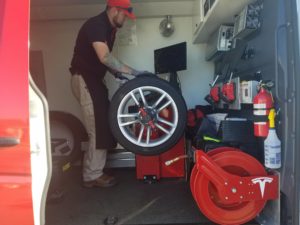Tire Service: Proven Approaches for Ideal Tire Upkeep and Treatment
Keeping ideal tire problem is vital for both safety and performance of any vehicle. From making certain correct tire pressure to regular turning and positioning, there are tried and tested methods that can dramatically prolong the life-span of your tires and enhance general driving experience. As we check out the details of tire care and upkeep, we will reveal necessary guidelines that every automobile proprietor must comply with for the ideal feasible outcomes. Allow's look into the world of tire solution and uncover the secrets to keeping your tires in excellent form for the lengthy haul.
Significance of Tire Stress
Appropriate tire stress promotes better gas effectiveness, as under-inflated tires can lead to raised rolling resistance, causing the engine to work tougher and take in more fuel. Correct tire stress ensures also walk wear, enhancing tire durability and conserving money in the long run by postponing the need for early replacements. Frequently checking and readjusting tire pressure, particularly in the past long trips, is a simple yet efficient method to enhance car performance, extend tire life expectancy, and focus on safety and security on the road.
Tire Turning Guidelines
When thinking about tire turning guidelines, it is necessary to recognize the relevance of this maintenance task in making the most of tire life expectancy and keeping optimal vehicle efficiency. Tire turning includes transforming the placement of each tire on a lorry to make sure even walk wear. Front tires tend to wear quicker than back tires because of steering pressures, making routine rotation critical for balanced wear patterns. The recommended rotation pattern varies depending upon whether a lorry is front-wheel, rear-wheel, all-wheel, or four-wheel drive. Typically, tires ought to be rotated every 5,000 to 7,500 miles, or as advised in the automobile handbook. Disregarding tire turning can lead to irregular wear, impacting handling, traction, and potentially compromising lorry safety. By sticking to appropriate turning guidelines, drivers can expand the life of their tires, enhance gas performance, and enhance total driving experience. Normal turning is a basic yet reliable maintenance practice that adds significantly to tire long life and car performance.

Advantages of Wheel Placement
Making certain correct wheel positioning after tire turning is important for maintaining well balanced wear patterns and taking full advantage of automobile efficiency. Wheel positioning describes the adjustment of the angles of the wheels to the supplier's requirements. One of the key advantages of wheel positioning is improved steering and dealing with feedback. When the wheels are correctly straightened, it minimizes steering initiative, ensuring a smoother and much more regulated driving experience. Furthermore, proper wheel placement aids to prolong the life expectancy of your tires. Misaligned wheels can create unequal tire wear, resulting in premature tire substitute and boosted maintenance expenses.

Tire Footstep Deepness Inspect
Executing a routine assessment of tire step deepness is vital for preserving risk-free driving problems and extending the lifespan of your tires. The step on your tires plays a crucial duty in giving traction, specifically in slippery or damp problems. To check your tire walk depth, you can use a walk depth gauge or the penny test. see here The recommended step deepness is at the very least 2/32 of an inch. It is time to replace your tires to make sure ideal efficiency and security on the roadway if the step his comment is here depth is below this threshold. Uneven tread wear can indicate issues with tire pressure, alignment, or suspension, highlighting the significance of routine tread deepness checks. Overlooking to monitor and preserve appropriate walk deepness can result in lowered hold, longer stopping distances, and a raised risk of hydroplaning. By including tire step deepness checks right into your routine upkeep routine, you can drive with confidence understanding that your tires remain in leading condition.
Seasonal Tire Evaluation
Seasonal tire inspection is a basic element of tire maintenance that makes certain tires are prepared to face the original site obstacles positioned by different climate conditions. In prep work for wintertime, it is vital to check the tire stress on a regular basis as cold temperature levels can trigger tire stress to go down. By performing regular seasonal tire inspections, chauffeurs can lengthen tire life-span, boost fuel efficiency, and most notably, make certain a safe driving experience in varying climate problems.
Verdict
To conclude, maintaining correct tire pressure, revolving tires frequently, lining up wheels appropriately, monitoring tread depth, and carrying out seasonal evaluations are essential techniques for ideal tire treatment. By complying with these verified techniques, vehicle drivers can guarantee their tires last longer, do better, and add to total lorry safety. It is necessary to prioritize tire maintenance to stop mishaps, boost fuel effectiveness, and prolong the life expectancy of tires.
Adequate tire pressure promotes far better gas performance, as under-inflated tires can lead to increased rolling resistance, causing the engine to function tougher and consume more gas.When taking into consideration tire rotation standards, it is important to understand the value of this maintenance task in making the most of tire lifespan and maintaining optimum car efficiency. Seasonal tire evaluation is a fundamental element of tire maintenance that makes certain tires are all set to encounter the obstacles posed by various weather problems. By performing routine seasonal tire inspections, chauffeurs can extend tire life-span, boost gas effectiveness, and most importantly, guarantee a safe driving experience in varying weather condition problems.
In conclusion, maintaining correct tire stress, turning tires on a regular basis, lining up wheels properly, keeping track of tread deepness, and carrying out seasonal evaluations are crucial practices for ideal tire treatment.